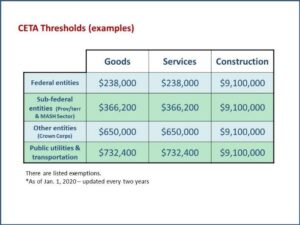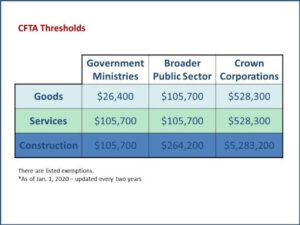As a company that provides education in public procurement, this is perhaps the most common question that arises. While there are many similarities, the nuances of public legislation and free trade requirements create a procurement environment that is more regulated, demands a greater level of transparency, and requires vigilance to stay on top of the constantly changing landscape.
similarities of public and private procurement
There are many similarities between public-and private-sector procurement practices. In both sectors, demonstrating value for money spent is a key obligation. In addition to other stakeholders, the public sector is accountable to taxpayers and auditors, while the private sector is under the watchful eye of a company’s board and its shareholders.
demand aggregation
As one strategy for meeting this obligation, both sectors look for opportunities for volume buying or ‘demand aggregation’ wherever possible and often approach strategic sourcing from a category management perspective.
compliance with policy
Both the public and the private sector are bound to comply with internal procurement and financial policies. This often includes a requirement to keep the contracting approvals process separate from the payment function.
responsible contracting practices
Often, a key consideration in both sectors is the use of environmentally friendly and socially responsible contracting practices. Additionally, both sectors are also careful to follow all applicable regulations, legislation, and common law precedents.
differences in public and private procurement
Perhaps the biggest difference between the public and the private sector is the key overriding consideration that drives procurement and contracting decisions.
profitability drives private procurement practices
In the private sector, where the primary procurement focus is profitability, the bottom-line analysis is generally the determining factor when procurement and contracting decisions are made.
public need leads public procurement practices
Public sector, on the other hand, is primarily responsible for providing effective and efficient services to the public; the primary emphasis, therefore, is on the public need, not profit.
This often means that a service or program that would not otherwise be available in the marketplace may be provided and/or developed to meet the needs of the public, even though such a procurement decision would not be considered ‘profitable’ in the eyes of the private sector.
private vs. public funding
Another key difference is that, because the public sector is spending taxpayers’ money, there tends to be far more scrutiny and public reporting of procurement activities. While private sector procurement may still come under scrutiny internally, and occasionally erupt into a public scandal, very rarely does a private sector procurement process gone wrong make front page news. Since governments depend primarily on voter confidence to remain in office, avoiding such negative publicity is of paramount importance to government bodies.
Educating staff about the risks and opportunities that public sector procurement activities provide is an important first step in heading off such scandals and public relations disasters. Because fairness and transparency of process in public procurement are paramount, both real and perceived conflicts of interest must be very carefully managed.
where do public sector procurement rules come from?
In addition to the common law court rulings that bind both public and private sector procurement activities, public sector procurement is obligated by two other layers. This is to facilitate the required level of fairness and transparency that includes:
- trade agreements and,
- freedom of information legislation.
Other jurisdictional nuances, such as Ontario’s Broader Public Sector Procurement Directive, provide additional guidance and outline more specific requirements.
1. trade agreements
Because the public sector is spending tax dollars, public sector bodies in Canada recognize the importance of acquiring goods, services and construction in a manner that can withstand objective scrutiny.
This generally means conducting an open, fair, and transparent competitive contracting process for any significant contract. Specific procurement requirements, including the dollar value thresholds beyond which a competitive process must be conducted, are typically embedded in internal policies and come from the various free trade agreements designed to eliminate discrimination based on jurisdiction of origin.
In addition to being subject to a web of international rules such as those under the World Trade Organization (WTO) Agreement on Government Purchasing and the United States-Mexico-Canada Agreement (USMCA), Canadian government procurement entities are also subject to the provisions of the Canada–European Union Comprehensive Economic and Trade Agreement (CETA) and the Canadian Free Trade Agreement (CFTA) which replaced the Agreement on Internal Trade in 2018.
While many of the free trade agreements only govern nation-to-nation disputes, the latter two treaties are of particular importance to procurement at all levels of government in Canada.
CETA obligations and public procurement
The CETA aims to harmonize trade between Canada and the EU with international standards. These obligations apply to both federal and sub-federal entities right down to the regional level, including most Crown corporations and public utilities.
The thresholds at which procuring entities are required to adhere to the CETA requirements are necessarily quite high and are subject to currency conversion and indexing rates.
In addition to requiring open and transparent procurement at or above these thresholds, CETA obligations for public procurement include:
- setting prescriptive time periods for advertising,
- rules related to electronic procurement,
- rules governing sole source procurement,
- and a number of new and onerous obligations.

This is particularly true for sub-federal entities. One example is the requirement that each procuring entity must provide a debriefing opportunity to unsuccessful respondents as well as allow for a robust bid challenge process.
At the provincial or territorial level, there is a requirement for an independent administrative or judicial review panel to hear challenges not resolved directly with the procuring entity.
The overall impact of the CETA is that Canadian companies bidding on large, lucrative federal, provincial and municipal procurements will encounter much more competition from EU companies than they have in the past. Canadian companies, for their part, now have greater access to EU government contracts.
Perhaps more impactful for public procurement professionals in Canada, the Canadian Free Trade Agreement (CFTA) applies to procurements by core government entities across Canada, as well as municipalities, academic institutions, school boards, and health and social service providers – collectively known as the MASH sector – and Crown corporations.
CFTA impact on public procurement
There are some enumerated exceptions in the CFTA, such as municipalities in the Yukon Territory and certain Crown and utility agencies from some jurisdictions.
Each party to the CFTA also has specific exceptions to the general provisions. For example, some have the right to derogate from the procurement requirements to promote regional economic developments.
The CFTA outlines obligations around debriefing, bid challenges processes and non-discriminatory practices as the CETA.
internal public policies provide guidance

Internal public procurement policies provide guidance on how the CETA and CFTA obligations specifically impact the organization’s procurement. The thresholds that trigger compliance with each trade agreement differ among core government, the MASH sector and Crown entities.
Any procurement at or above the specified threshold must be publicly advertised as directed in the agreements. They are designed to allow maximum competitive tension for government contracts and to eliminate discrimination based on jurisdiction of origin.
And because acquiring goods and services through an open competitive process generally encourages innovation and ensures that taxpayers are receiving true value for the money spent, public sector tends to respect the spirit and intent of these agreements, even for smaller-dollar, under-threshold contract opportunities wherever it is reasonable to do so.
2. freedom of information legislation
A key piece of legislation that is remarkably similar in every Canadian province and territory, and significantly influences procurement policy, deals with freedom of information and protection of privacy.
Freedom of Information Legislation strives to balance two competing public interests:
- that every citizen has a right to know how his or her tax dollars are being spent. At the same time, however, citizens are entitled to the right of privacy; to have their personal information protected from disclosure.
From a procurement perspective, the freedom of information portion of the legislation is designed to allow for inquiry and investigation into how funds are spent, including any mishandling, misappropriation, or unfair practices.
Because the starting point for such legislation is that the public has a right to know, disclosure will be required unless the information falls within an exempt category. Generally speaking, the exemptions relate to commercial, financial or scientific information, or information the disclosure of which could reasonably be expected to harm the interests of a third party.
Under these statutes, the onus is on the person or organization that is resisting disclosure to prove that the information falls within one of the exempted categories.
conclusion
The bottom line is that procurement in the public sector is governed by a more complex web of obligations and is subject to much more scrutiny and oversight than private sector procurement.
If you are new to public procurement or would like to update your skills and knowledge in this ever-shifting area of practice, check out this free preview: https://theprocurementschool.articulate-online.com/5190780187 of our online PSPP 101 Essentials course.
Author: Maureen Sullivan, Director of Education at The Procurement School.
Maureen is currently responsible for our curriculum design, customer liaison, and instructor development. Maureen has been an instructor and curriculum designer with The Procurement School since 1995. She also played the role of President at The Procurement School for over a decade. An experienced litigator, mediator and dispute resolution practitioner, Maureen has an in-depth knowledge of both procurement law and contracting issues with particular expertise in negotiations. She is the author of A Guide to Practical Procurement, and in her spare time she volunteers with Restorative Justice.
Disclaimer: The views and opinions expressed in this article are those of the Subject Matter Experts and do not necessarily reflect the official policy or position of The Procurement School.

One thought on “what is the difference between public and private sector procurement?”